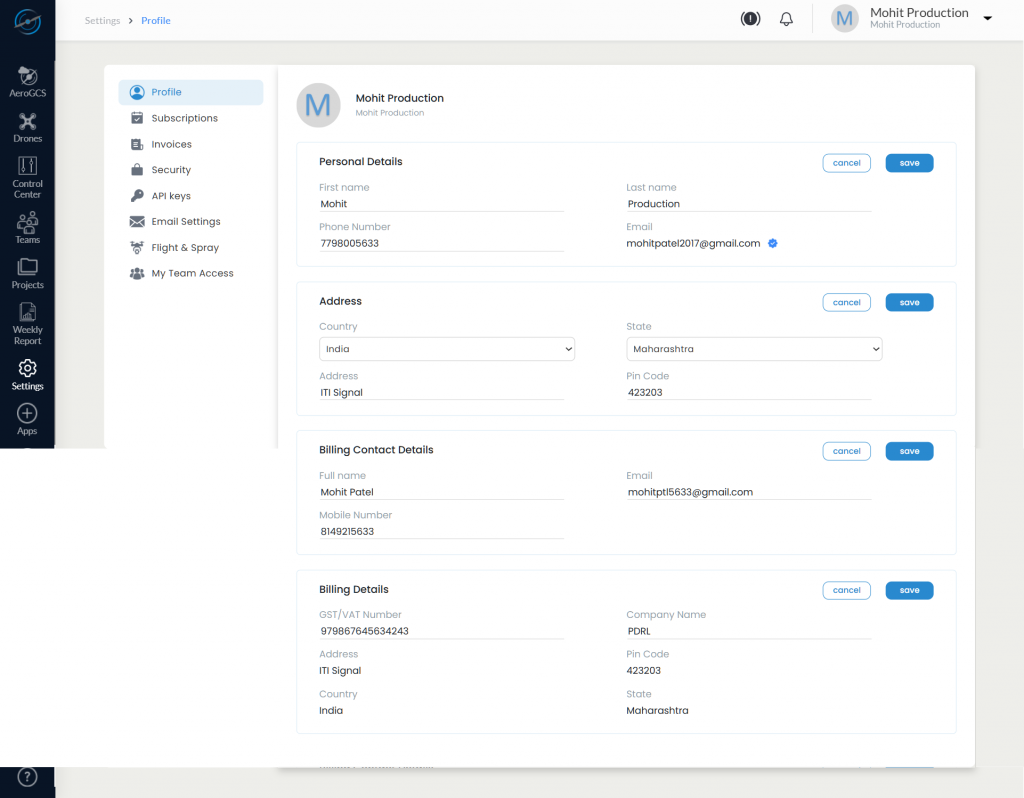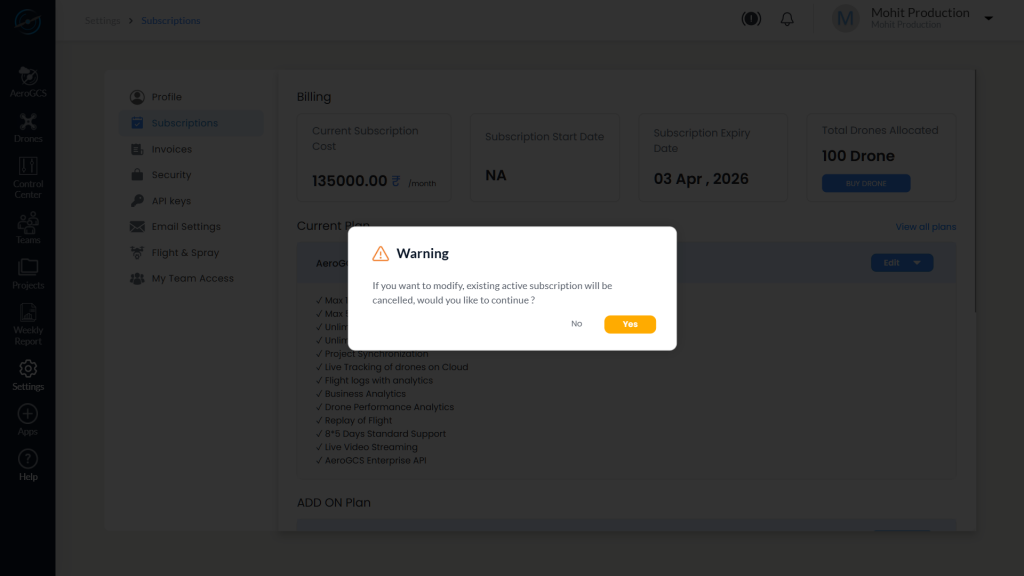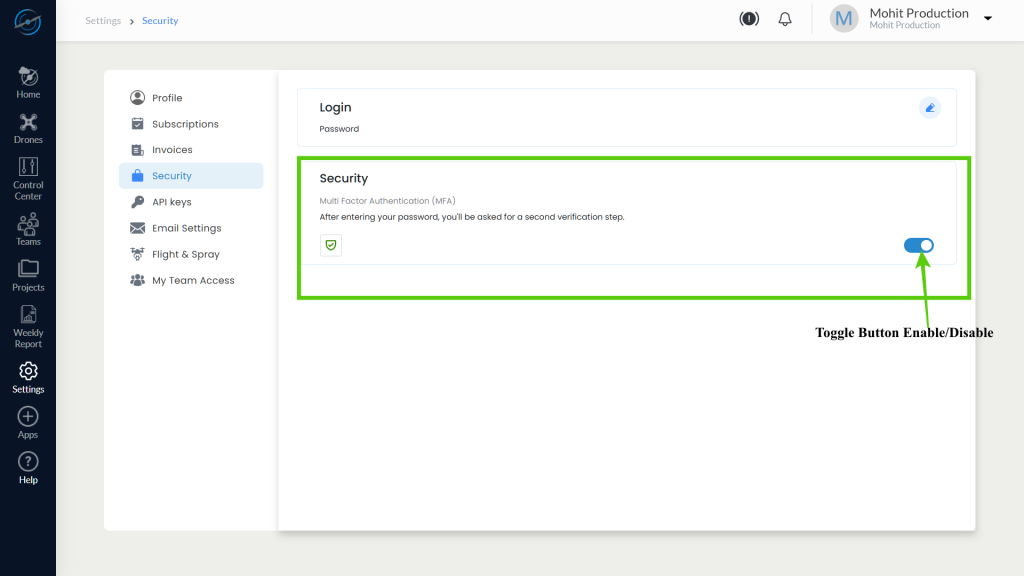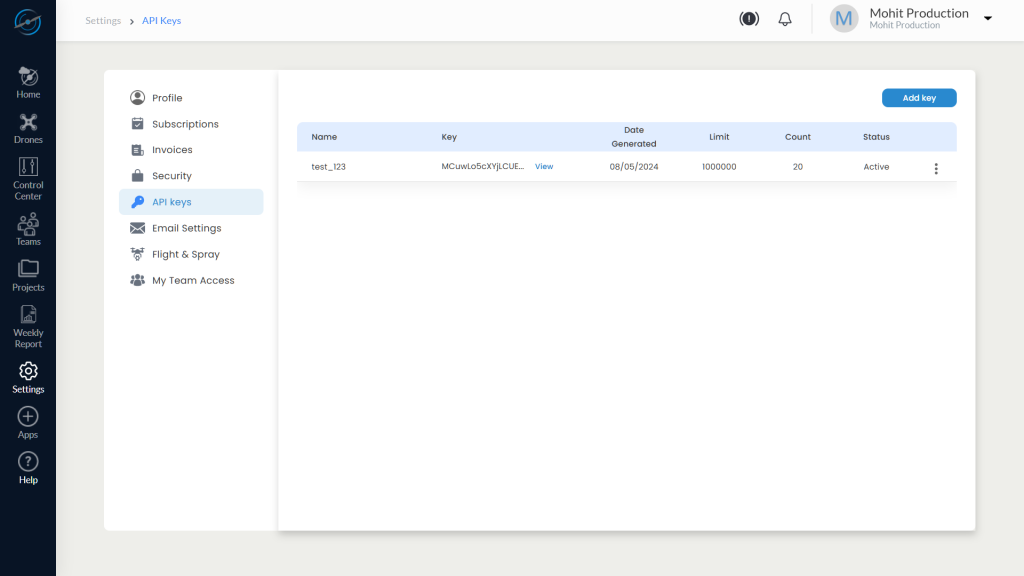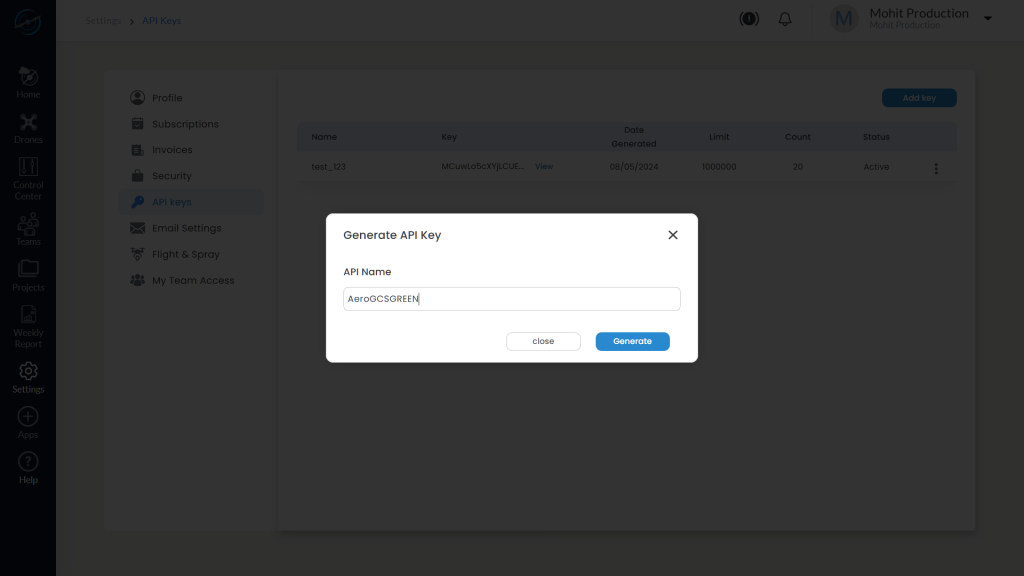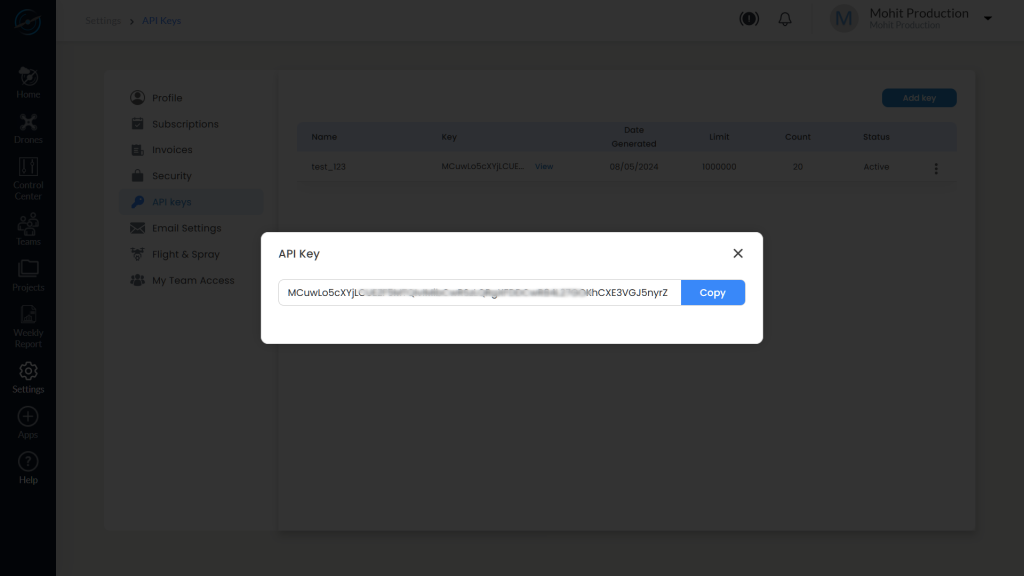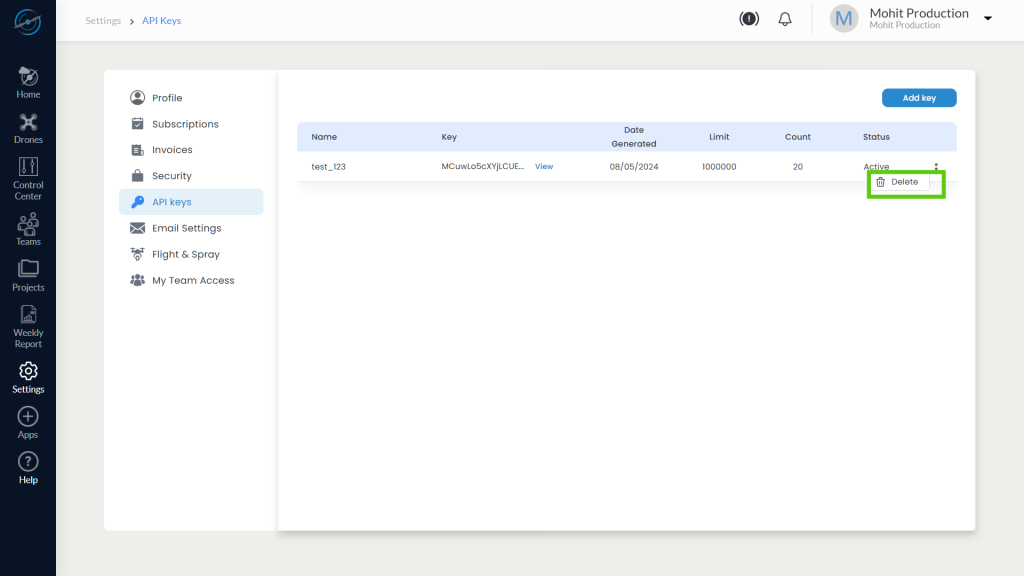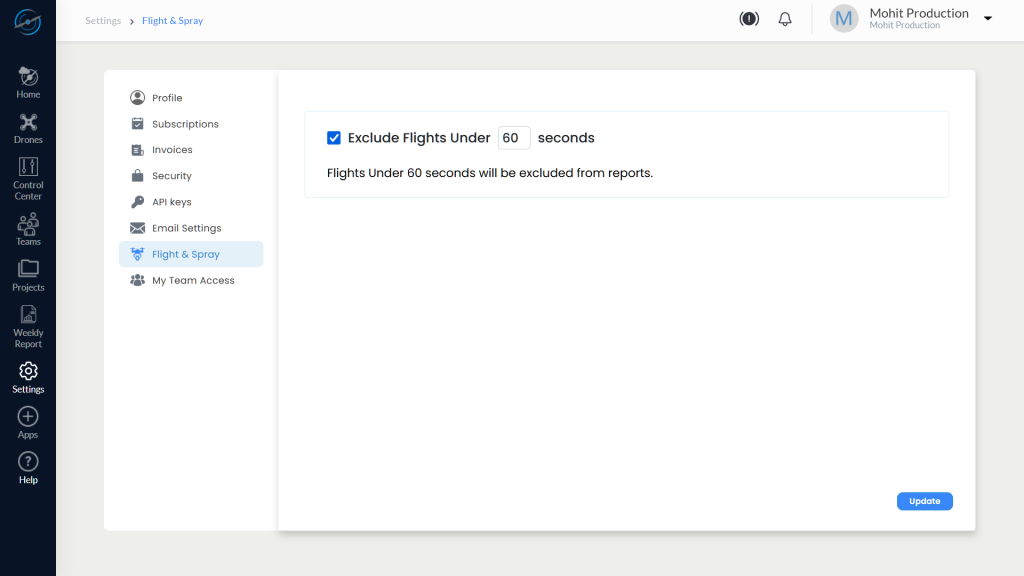-
AeroGCS Enterprise User Manual
11. Settings
Tailor Your User, Security, and Flight Preferences in One Central Location
Introduction
The Settings module in AeroGCS Enterprise enables users to configure key personal and system-level preferences for a seamless operational experience. Whether you need to update your profile information, manage subscriptions, change security credentials, or customise your email alerts—this centralised interface gives you complete control.
Settings are segmented into clear sections, allowing for easy navigation and focused adjustments. Each setting tab is designed to support your role-specific needs—whether you’re a project manager, pilot, or admin user—ensuring your environment remains aligned with your workflow and responsibilities.
💡 Tip: Keeping your settings up to date ensures smooth coordination across your team and accurate data synchronisation across AeroGCS systems.
11.1 Accessing the Settings Panel
To begin managing your preferences, follow these steps to access the Settings module from within the AeroGCS Enterprise interface.
Steps to Access Settings:
- Log in to your AeroGCS Enterprise account using your registered credentials.
- In the top-right corner of the dashboard, click on your profile icon (this may display your initials or profile photo).
- From the dropdown menu, click on Settings.
UI Path: Top Navigation Bar → Profile Icon → Settings - You will be redirected to the Settings Panel, where a vertical tab list is displayed on the left side of the screen.
- Available tabs include:
– Profile
– Subscriptions
– Invoices
– Security
– API Keys
– Email Settings
– Flight & Spray
– My Team Access
11.2 Profile
The Profile section in the Settings module allows users to view and update their personal information, address details, billing contact, and GST/VAT-related billing details. This helps ensure that your user identity and financial contact information are accurate and up to date for team collaboration, support, and invoicing.
You can edit each information block separately using the dedicated Edit, Save, and Cancel actions provided within the respective sections.
Fields Available in the Profile Tab
The profile tab consists of four collapsible panels:
1. Personal Details
Displays the primary user identity and contact information.
Field | Description |
First Name | The user’s first name (editable) |
Last Name | The user’s surname (editable) |
Registered email ID (non-editable if logged in via Google or Microsoft SSO) | |
Phone Number | Contact number of the user (editable) |
2. Address
Represents the physical address of the user or organisation.
Field | Description |
Country | Country name (editable) |
State | State name (dropdown) |
Pin Code | Postal code (editable) |
Address | Local address (editable) |
3. Billing Contact Details
Used for communication and invoice delivery.
Field | Description |
Full Name | Billing contact person’s name |
Mobile Number | Billing contact’s phone number |
Billing contact’s email address |
4. Billing Details
Essential for GST compliance and invoice generation.
Field | Description |
GST/VAT Number | Tax identification number (editable) |
Company Name | Registered company name |
Address | Billing address |
Country | Billing country |
State | Billing state |
Pin Code | Billing postal code |
Editing Your Profile Information
To update any section of your profile:
- Navigate to Settings → Profile from the left sidebar.
- Locate the section you want to update (e.g., Personal Details, Address, Billing).
- Click the ✏️ Edit icon on the top-right of the section.
4. The section fields will switch to Edit Mode with input boxes and dropdowns.
5. Modify the values as needed.
6. Click Save to apply the changes.
Alternatively, click Cancel to discard your edits.
Note:
- The Email Address field is locked if your account is authenticated via Google or Microsoft.
- Ensure your billing details match your GST records to avoid compliance issues.
💡 Tip: Keep your billing contact details updated to ensure all system-generated invoices and billing alerts reach the appropriate recipient.
Summary Table
Section | Editable | Purpose |
Personal Details | ✅ | Identifies the user on the platform |
Address | ✅ | Defines user or organisational location |
Billing Contact Details | ✅ | Specifies billing communication contact |
Billing Details | ✅ | Used for GST-compliant invoicing |
11.3 Subscriptions
Manage your AeroGCS Enterprise subscription, add-ons, and usage limits
The Subscriptions section allows you to manage your primary AeroGCS Enterprise plan, monitor billing information, view expiry dates, purchase drone add-ons, and track overall storage and drone usage. You can also upgrade or modify your active plan, with necessary warnings and confirmations to ensure safe billing transitions.
This section is divided into the following sub-panels:
- Billing Summary
- Current Plan
- Add-On Plan
- Usage Overview
11.3.1 Billing Summary
This panel provides a quick snapshot of your subscription billing information.
Field | Description |
Current Subscription Cost | Displays the base monthly cost of the AeroGCS Enterprise plan. Example: ₹135,000.00/month |
Subscription Start Date | Date when the current subscription was activated (may show NA if not available). |
Subscription Expiry Date | Date when the current plan is set to expire. Example: 03 Apr, 2026 |
Total Drones Allocated | Maximum number of drones allowed under your plan. Example: 100 Drones |
You can also click the Buy Drone button to purchase additional drone slots.
This action immediately applies the purchased drone licences to your current subscription and is independent of the Add-On Plan modification process.
11.3.2 Current Plan
The Current Plan section displays detailed information about your active subscription package.
AeroGCS Enterprise Plan – Included Features:
- Support for up to 100 drones
- 500 GB storage for mission and analytics data
- Unlimited teams and users
- Project synchronisation
- Flight logs with analytics
- Business and drone performance analytics
- Flight replay and live video streaming
- 8×5 standard support
- API access for system integration
Modifying the Current Plan
To initiate a change:
- Click the Edit button in the Current Plan card.
- From the dropdown, select Modify.
⚠️ When modifying an active plan, a warning will appear:
“If you want to modify, existing active subscription will be cancelled. Would you like to continue?”
3. Click Yes to proceed or No to cancel.
4. Proceed with buying new plan.
⚠️ Important: Modifying a subscription immediately cancels your existing plan and triggers a fresh billing cycle.
💡 Tip: Only use the Modify option when you’re ready to switch plans or change subscription levels.
11.3.3 Add-On Plan
Configure post-subscription drone add-ons for future operations
The Add-On Plan section is used to manage additional drone capacity after your current subscription expires. It allows you to reconfigure or extend drone capacity through a new drone add-on plan using the Edit → Modify option.
Example Entry:
AeroGCS Enterprise Add-On Drones
- 7 Drones Added
- Expiry Date: 01 Jan 2025
This section helps manage drone licence extensions tied to the subscription renewal or change process, rather than mid-cycle purchases.
Modifying the Add-On Plan
If your current subscription has expired and you want to add drones for a renewed or updated plan:
- Click Edit in the Add-On Plan section.
- Select Modify from the dropdown.
- Follow on screen instructions to buy Add on Plan.
⚠️ Note: This path is only applicable after the current plan has expired or been cancelled. Active subscriptions must not be modified directly through this option without understanding the implications.
⚠️ Important Distinction:
- The Buy Drone button under Billing is for real-time, mid-cycle drone slot purchases during an active subscription.
- The Edit → Modify option in Add-On Plan is used for post-expiry plan changes or when reconfiguring add-ons for a new subscription cycle.
💡 Tip: To expand drone capacity during an active plan, always use the Buy Drone button from the Billing section for instant access without disrupting your subscription.
11.3.4 Usage Overview
Monitor real-time consumption of your allocated resources:
a. Storage Usage
Displays the proportion of your cloud storage currently used.
Metric | Value Example |
Used | 3.0648 GB |
Limit | 500.0000 GB |
% Used | 0.61% |
b. Drone Usage
Displays the number of drones registered against your plan quota.
Metric | Value Example |
Total Drones | 100 |
Registered Drones | 18 |
Available Drones | 82 |
A progress bar visualises quota usage.
💡 Tip: Monitor storage and drone usage regularly to avoid service interruptions and ensure seamless mission operations.
Summary Table
Section | Description |
Billing Summary | Displays cost, dates, and drone allocation |
Current Plan | Shows plan features and enables modifications |
Add-On Plan | Purchase additional drone slots |
Usage Overview | Track storage used and drones registered vs. allocated |
⚠️ Best Practices:
- Review your expiry date and plan limits before critical missions.
- Use the Buy Drone button proactively if approaching quota limits.
- Be cautious when modifying plans—this cancels your current subscription.
11.4 Invoices
View and manage your billing history and pending payments
The Invoices section in the AeroGCS Enterprise Settings module provides a detailed record of all invoices generated for your organisation’s subscriptions, add-ons, and billing activities. This section allows you to track invoice status, monitor payment deadlines, and take immediate action on unpaid invoices using the Pay Now option.
Accessing the Invoices Panel
To access your invoice history:
- Go to the Settings menu from the profile dropdown.
- Click the Invoices tab from the left-hand sidebar.
You will see a chronological table of all invoices generated under your registered account.
Invoice Table Overview
The invoice table displays key billing details for each transaction in a compact, scrollable view.
Column | Description |
Invoice Number | Unique identifier generated for each billing transaction (e.g., ENT000217) |
Product | The subscribed plan or add-on purchased (e.g., AeroGCS Enterprise Business Monthly) |
Date & Time | The exact timestamp when the invoice was issued (date and time in IST) |
Amount | Total payable amount in INR for that invoice (e.g., ₹14,250) |
Status | Indicates the payment status: Paid or Pending |
Action | A Pay Now button appears for invoices with a Pending status |
Paying Pending Invoices
If an invoice is unpaid, the status will appear as Pending, and a Pay Now button will be displayed.
Steps to Complete Payment:
- Click the Pay Now button next to the pending invoice.
- A payment gateway window will open.
- Choose your preferred payment method (e.g., UPI, credit/debit card, net banking).
- Complete the payment securely.
- Upon successful payment:
- The status will update to Paid.
- A payment confirmation will be reflected in the invoice record.
⚠️ Note: You must clear pending invoices to avoid service disruptions or restrictions on subscription-related activities.
Tips & Best Practices
- Use Invoice Number as a reference when contacting support or accounting teams.
- Ensure the billing contact email in your profile is accurate to receive automated invoice alerts.
- Download or print invoices for compliance or internal auditing (if download option is enabled in future versions).
Summary Table
Feature | Description |
View Invoices | Displays full billing history in table format |
Invoice Number | Unique transaction ID for each billing event |
Status | Paid or Pending status per invoice |
Pay Now | Instant payment option for unsettled invoices |
Payment Timestamp | Includes date and time of invoice generation |
11.5 Security
Strengthen your account with password management and two-step authentication
The Security tab in the AeroGCS Enterprise Settings panel allows users to manage their login credentials and enable additional protection through Multi-Factor Authentication (MFA). These controls are designed to ensure that only authorised users can access their accounts, and provide additional protection from unauthorised logins.
This section is divided into two parts:
- Password Management
- Multi-Factor Authentication (MFA)
11.5.1 Password Management
This section allows users to update their login password securely.
You will see a Login section with an Edit button.
Steps to Change Password:
1. Click the Edit button.
2. The interface expands to show three input fields:
- Current Password
- New Password
- Confirm Password
3. Each field includes a view/hide icon to toggle password visibility.
4. After entering all required values:
- Click Change to update the password.
- Click Cancel to discard the update.
Password Update Tips
- Choose a strong password containing uppercase and lowercase letters, numbers, and special characters.
- Avoid reusing previous passwords or using predictable sequences.
⚠️ Note: If the current password is entered incorrectly, the change will be rejected, and an error message will appear.
11.5.2 Multi-Factor Authentication (MFA)
Add an extra layer of security to your login process
Multi-Factor Authentication (also known as Two-Step Authentication) enhances security by requiring a second verification step during login.
You will see a section labelled Security: Multi-Factor Authentication (MFA) with an Enable/Disable toggle.
Steps to Enable MFA:
- Toggle the Enable switch.
- You will be prompted to enter your current password.
- Once verified, an OTP (One-Time Password) will be sent to your registered contact.
- Enter the OTP to complete activation.
Upon successful setup, a message will be shown:
“Two-step authentication is enabled.”
Disabling MFA:
- Toggle the switch back to Disable.
- Enter your password for confirmation.
- MFA will be deactivated.
Important: Enabling MFA is strongly recommended to protect against unauthorised access. This setting applies to your login experience across all AeroGCS Enterprise interfaces.
💡 Tip: If you lose access to your OTP method, contact your admin or PDRL support to reset authentication settings.
Summary Table
Feature | Action Required |
Change Password | Enter current, new, and confirm password |
View/Hide Password Fields | Toggle icon beside each input field |
Enable Multi-Factor Authentication | Toggle switch → Password → OTP verification |
Disable MFA | Toggle switch → Confirm password |
Confirmation Message | “Two-step authentication is enabled.” |
11.6 API Keys
Securely generate and manage API access to integrate with AeroGCS Enterprise
The API Keys section allows users to generate and manage API credentials for programmatic access to AeroGCS Enterprise services. These keys enable integrations with third-party applications, automation scripts, and internal systems—while enforcing usage limits and access control.
All API keys are tied to the user’s account and should be handled securely.
11.6.1 API Key Table Overview
Upon opening the API Keys tab, you will see a table displaying all previously generated keys associated with your account.
Column | Description |
Name | The label you assigned to the API key during creation |
Key | A masked version of the actual API key with a View option |
Date Generated | Timestamp when the key was created |
Limit | Total allowed number of API calls |
Count | Number of API calls made using the key |
Status | Displays whether the key is Active |
11.6.2 Generating a New API Key
To create a new API key:
- Click the Add Key button at the top of the screen.
- A pop-up titled Generate API Key will appear.
- Enter a meaningful name in the API Name field (e.g., test_123).
- Click Generate to create the key.
- The new API key will be added to the table with default usage limits.
11.6.3 Viewing and Copying an API Key
For security, API keys are masked by default.
- Click the View button in the Key column for the desired entry.
- The full key will be revealed in a secure display.
- Click the Copy icon next to the key to copy it to your clipboard.
⚠️ Warning:
Treat API keys like passwords. Do not share them publicly or embed them in unsecured code.
11.6.4 Deleting an API Key
To revoke access and delete an API key:
- Click the three-dot menu (︙) at the end of the row for the target key.
- Select Delete.
- Confirm the deletion when prompted.
The deleted key will be removed and cannot be used for future API calls.
Summary Table
Action | Steps |
Add API Key | Click Add Key → Enter name → Click Generate |
View API Key | Click View in key column |
Copy API Key | Use Copy icon in view modal |
Delete API Key | Click ︙ (three dots) → Select Delete |
Track Usage | Monitor Count vs Limit in the API Key table |
💡 Tip: Regularly rotate your API keys and delete unused keys to reduce security risks.
⚠️ Note: Each API key is assigned a usage limit and is monitored for count of calls. Exceeding limits may result in throttling or temporary suspension of access.
11.7 Email Settings
Manage email recipients and configure notifications for system alerts and reports
The Email Settings section in AeroGCS Enterprise allows administrators and users to configure which email addresses receive automated notifications for important system events such as drone health reports, weekly summaries, software updates, and error logs.
This feature ensures that key stakeholders are kept informed of operational status, performance metrics, and potential issues.
11.7.1 Overview of Email Settings Table
Upon accessing the Email Settings tab, you will see a table listing the currently configured email addresses and their selected notification types.
Column | Description |
The recipient email address | |
Drone Health Report | Checkbox to enable/disable health report notifications |
Weekly Report | Checkbox to receive summary emails on a weekly basis |
Software Update | Checkbox to receive alerts for software releases or patches |
Error Logs | Checkbox to receive logs when errors are detected in mission or platform |
Action | Contains a Delete icon to remove the email entry from the list |
You can toggle the checkboxes to enable or disable specific types of email notifications for each address.
Once changes are done Click “Update” to save and apply the changes for email notifications for the users.
11.7.2 Adding a New Email Recipient
To add a new recipient and configure their email preferences:
- Click the Add Email button located above the table.
- A dialog box titled Add Email will appear.
- Enter the Email ID in the input field.
- Click Add to confirm, or Cancel to discard.
5. The new email will be added to the table with all notification types initially unchecked.
6. Select the desired checkboxes for the types of emails the new recipient should receive:
- Drone Health Report
- Weekly Report
- Software Update
- Error Logs
⚠️ Note: Emails added must be valid and accessible. Incorrect addresses will not receive notifications.
11.7.3 Deleting an Email
To remove an existing recipient from the notification list:
- Locate the email entry in the table.
- Click the Delete icon in the Action column.
- Confirm deletion when prompted.
Once deleted, the recipient will no longer receive any automated notifications from the system.
Summary Table
Feature | Action |
Add Email | Click Add Email → Enter ID → Add |
Configure Types | Use checkboxes to toggle report types per email |
Delete Email | Click Delete icon next to the target email |
Notification Types | Drone Health, Weekly Report, Software Update, Error Logs |
💡 Tip: Use this feature to ensure relevant team members, maintenance staff, or managers are promptly alerted about critical drone and software events.
⚠️ Security Note: Only authorised users should have permission to add or remove emails to maintain control over sensitive system communications.
11.8 Flight & Spray
Configure filters to refine flight data reporting
The Flight & Spray section in AeroGCS Enterprise allows you to exclude short-duration flights—typically trial runs, hardware checks, or aborted missions—from being counted in system reports. This helps maintain accurate analytics by omitting incomplete or insignificant flight data.
11.8.1 Exclude Flights Under Seconds
This feature enables users to filter out flights that are shorter than a specified duration. These excluded flights will not appear in performance metrics, flight reports, or analytics dashboards.
How to Configure:
- Go to Settings → Flight & Spray.
- Enable the toggle for Exclude Flights Under Seconds.
- In the input field that appears, specify the minimum flight duration threshold (in seconds).
– Default Value: 60 seconds - Click the Update button to apply the change.
Once saved, flights with a total duration less than the specified number of seconds will be ignored across all system-generated reports.
⚠️ Note: This filter only affects reporting and analytics. The actual flight logs will remain accessible in the system.
💡 Tip: Use this setting to avoid cluttering reports with test flights or drone arm/disarm events under field conditions.
Summary Table
Setting | Description |
Exclude Flights Under Seconds | Omits short-duration flights from all reports |
Default Threshold | 60 seconds |
Editable Field | ✅ (User-defined) |
Action Button | Update to save new threshold value |
11.9 My Team Access
View your access roles across teams, projects, and drones
The My Team Access section provides a user-specific overview of team affiliations and assigned roles within projects and drones across the AeroGCS Enterprise platform. It offers visibility into who owns which team and what level of access (e.g. Pilot, Viewer) you hold across various resources.
This is a read-only view designed to enhance transparency and simplify role tracing across collaborative environments.
The interface consists of three collapsible data panels:
- Owners
- My Project Access
- My Drone Access
11.9.1 Owners
This section lists the teams you are a member of and displays the corresponding team owners.
Column | Description |
Team Name | Name of the team you are part of |
Owner | Email ID of the team owner |
11.9.2 My Project Access
Shows a breakdown of your access across projects within various teams.
Column | Description |
Project Name | The name of the project you are part of |
Role | Your assigned role in that project (e.g. PILOT) |
Team Name | The team to which the project belongs |
Owner | Owner of the team who controls access |
💡 Tip: Roles such as PILOT, VIEWER, or MANAGER may determine your functional capabilities like flight planning, viewing reports, or team management.
11.9.3 My Drone Access
Displays your assigned roles on specific drones within teams (if any). If there are no drone roles assigned, this section will remain empty.
Column | Description |
Drone ID | Unique identifier of the drone |
UIN | Unique Identification Number (if available) |
Role | Assigned role on the drone (e.g. Operator) |
Team Name | Team to which the drone is assigned |
Owner | Owner of the team or drone |
⚠️ Note: If no drone roles have been assigned to your account, you will see a placeholder graphic indicating empty access records.
Summary Table
Section | Purpose |
Owners | Displays team owners for teams you belong to |
My Project Access | Shows your project-level roles across teams |
My Drone Access | Lists drones where you have operational access (if assigned) |
💡 Best Practice: Use this section to audit your access and ensure you’re correctly assigned to projects and drones. For changes, contact your team manager or admin.
11.10 Summary
A quick reference to all configurable settings in AeroGCS Enterprise
The table below provides a consolidated overview of all sub-sections available under the Settings module. Use this as a reference to understand the purpose, key actions, and benefits of each configuration area.
Settings Tab | Purpose | Key Actions |
Profile | View and update personal info, billing contacts, and address details | Edit name, phone, address, GST number, billing email; Save or Cancel changes |
Subscriptions | Monitor current plan, add-ons, and resource usage | View subscription, expiry, and drone count; Buy drones; Modify plan after expiry |
Invoices | View billing history and settle pending payments | View invoice records; Pay Now for unpaid invoices |
Security | Manage login credentials and enhance account security | Change password; Enable or disable multi-factor authentication (MFA) |
API Keys | Generate and manage API credentials for integrations | Add new key; View/copy/delete existing keys; Track API usage count |
Email Settings | Manage who receives system alerts and reports | Add email; Enable/disable notifications for each report type; Delete recipients |
Flight & Spray | Filter short-duration flights from reports | Set minimum flight duration (in seconds); Enable/disable filter; Update setting |
My Team Access | View assigned roles across teams, projects, and drones | View team ownership, project roles, and drone access (read-only) |
💡 Tip: Revisit the Settings module regularly to review and update your preferences, especially when your team structure or drone operations evolve.
⚠️ Note: Some tabs may display limited access based on your assigned role or login method (e.g., SSO users may not be able to change their email/password).


